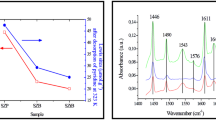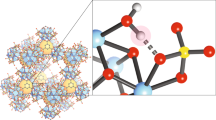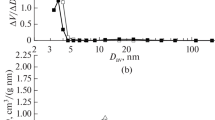Abstract
Concentrations of Brønsted and Lewis acid sites on sulfated-zirconia catalysts were determined using the31P MAS NMR spectra of adsorbed trimethylphospine. A sample that had been calcined and exposed to air for a long period exhibited only Brønsted acidity; however, treatment of the sample at progressively higher temperatures resulted in the development of at least three types of Lewis acidity, along with a decrease in the concentration of Brønsted acid sites. In a related study the activity of these catalysts for the alkylation of isobutane with 2-butene was determined. The aged catalyst was inactive, but activation of the material at 100°C resulted in the most active catalyst. Thermal treatment at higher temperatures resulted in a loss in activity which paralleled the decrease in the Brønsted acid sites. These results are consistent with a model in which strong Brønsted acidity is a result of the interaction between bisulfate groups and adjacent Lewis acid sites.
Similar content being viewed by others
References
K. Arata, Adv. Catal. 37 (1990) 165.
C. Morterra, G. Cerrato, C. Emanuel and V. Bolis, J. Catal. 142 (1993) 349.
W.P. Rothwell, W.X. Shen and J.H. Lunsford, J. Am. Chem. Soc. 106 (1984) 2452.
J.H. Lunsford, W.P. Rothwell and W. Shen, J. Am. Chem. Soc. 107 (1985) 1540.
J.H. Lunsford, P.N. Tutunjian, P. Chu, E.B. Yeh and D.J. Zalewski, J. Phys. Chem. 93 (1989) 2590.
P.-J. Chu, A. deMallman and J.H. Lunsford, J. Phys. Chem. 95 (1991) 7362.
T.-C. Sheng, P. Kirszensztejn, T.N. Bell and I.D. Gay, Catal. Lett. 23 (1994) 119.
D.J. Coster, A. Bendada, F.R. Chen and J.J. Fripiat, J. Catal. 140 (1993) 497.
T.-C. Sheng and I.D. Gay, J. Catal. 145 (1994) 10.
R.G. Dosch, H.P. Stephens and F.V. Stohl, US Patent 4, 511, 455 (1985).
C.-H. Liang and R.G. Anthony, Catal. Today, submitted.
P.-J. Chu, J.H. Lunsford and D.J. Zalewski, J. Magn. Reson. 87 (1990) 68.
D.J. Zalewski, P. Chu, P.N. Tutunjian and J.H. Lunsford, Langmuir 5 (1989) 1026.
A. Clearfield, Catal. Today, in press.
C.W. Schultz and R.W. Rudolph, J. Am. Chem. Soc. 93 (1971) 1898.
Y. Sun, S.M. Campbell, J.H. Lunsford, G.E. Lewis, D. Palke and L.-M. Tau, J. Catal. 143 (1993) 32.
Author information
Authors and Affiliations
Rights and permissions
About this article
Cite this article
Lunsford, J.H., Sang, H., Campbell, S.M. et al. An NMR study of acid sites on sulfated-zirconia catalysts using trimethylphosphine as a probe. Catal Lett 27, 305–314 (1994). https://doi.org/10.1007/BF00813917
Received:
Accepted:
Issue Date:
DOI: https://doi.org/10.1007/BF00813917




